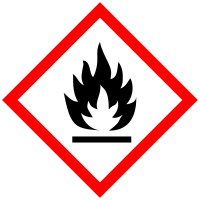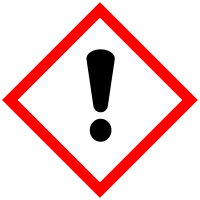
Improving Member States preparedness to face an HNS pollution of the Marine System (HNS-MS)
Propylene Glycol Methyl Ether
Description Top
| CAS number | 107-98-2 |
| UN number | 3092 |
| Chemical formula | C4H10O2 |
| Standard European Behaviour Classification (SEBC) | Dissolves (D) |
| Abilities | Miscible in water. |
GESAMP Hazard profile
| A1 | A2 | B1 | B2 | C1 | C2 | C3 | D1 | D2 | D3 | E1 | E2 | E3 |
| NI | NI | NI | NI | NI | NI | NI | NI | NI | NI | D | NI |
Marine pollution Classification (MARPOL Annex II)
| Category | Description |
| Z | Noxious Liquid Substances which, if discharged into the sea from tank cleaning or deballasting operations, are deemed to present a minor hazard to either marine resources or human health and therefore justify less stringent restrictions on the quality and quantity of the discharge into the marine environment. |
Alternate names for this chemical
1,2-Propylene Glycol Monomethyl Ether
1-Methoxy-2-Propanol
Propylene Glycol Methyl Ether
Ether Methylique De Propylene Glycol
1-Methoxy-2-Propanol
Propylene Glycol Methyl Ether
Ether Methylique De Propylene Glycol
Physico-chemical properties Top
| Chemical formula | C4H10O2 | ||
| Molar mass | 90.121 [g/mol] | ||
| State | Liquid at 25°C and 1 atm | ||
| Fusion temperature | -95 [°C] | ||
| Boiling temperature | 119 [°C] | ||
| Critical temperature | 579.8 [°C] | ||
| Density |
|
||
| Surface tension |
|
||
| Kinematic viscosity |
|
||
| Hydrosolubility |
|
||
| Vapour pressure |
|
||
| Critical pressure | 4113000 [Pa] | ||
| Vapour density | 3.11 | ||
| Flash point (Pensky-Martens closed cup) | 32 [°C] | ||
| Flash point (Cleveland open cup) | 36 [°C] | ||
| Combustion enthalpy | 25857120 [J/Kg] | ||
| Specific heat capacity | 2426 [J/(Kg·K)] | ||
| Henry's constant | 0.09 [mol/(m³·Pa)] |
Behaviour Top
| Log Kow | -0.49 |
| Log Koc | 0 |
| Hydrolysis (Half-life) | Not hydrolysable |
| Aqueous photolysis (Half-life) | Not photolysable |
| Standard European Behaviour Classification (SEBC) | Dissolves (D) |
| Bioconcentration factor (BCF) | 3.2 |
Ecotoxicity Top
| Lowest median lethal concentration (LC50) on crustacean | 23300 [mg/l] | |
| Assessment factor (AF) |
|
|
| Predicted No Effect Concentration (PNEC) |
|
Hazards Top


Warning
Hazards statements
Physical
H226
Flammable liquid and vapour.
Health
H336
May cause drowsiness or dizziness.
Precautionary statements
Prevention
P210
Keep away from heat/sparks/open flames/hot surfaces. No smoking.
P233
Keep container tightly closed.
P240
Ground/bond container and receiving equipment.
Response
P370 + P378
In case of fire: Use ... for extinction.
Storage
P403 + P235
Store in a well-ventilated place. Keep cool.
Disposal
P501
Dispose of contents/container to ...
GESAMP Top
GESAMP Hazard profile
| A1 | A2 | B1 | B2 | C1 | C2 | C3 | D1 | D2 | D3 | E1 | E2 | E3 |
| NI | NI | NI | NI | NI | NI | NI | NI | NI | NI | D | NI |
A1: Bioaccumulation
| Rating | Description |
| NI | No Information |
A1a:
| Rating | Description |
| NI | No Information |
A1b:
| Rating | Description |
| NI | No Information |
A2: Biodegradation
| Rating | Description |
| NI | No Information |
B1: Acute aquatic toxicity
| Rating | Description |
| NI | No Information |
B2: Chronic aquatic toxicity
| Rating | Description |
| NI | No Information |
C1: Acute oral toxicity
| Rating | Description |
| NI | No Information |
C2: Acute dermal toxicity (skin contact)
| Rating | Description |
| NI | No Information |
C3: Acute inhalation toxicity
| Rating | Description |
| NI | No Information |
D1: Skin irritation or corrosion
| Rating | Description |
| NI | No Information |
D2: Eye irritation
| Rating | Description |
| NI | No Information |
D3: Long-term health effects
| Notation | Hazard endpoint | Description | GHS category |
| No Information |
E1: Tainting of seafood
| Rating | Description |
| NI | No Information |
E2: Behaviour of chemicals in the marine environment
| Rating | Description |
| D | Dissolves |
E3: Interference with the use of coastal amenities
| Rating | Description |
| NI | No Information |
GHS Security Information


Warning
About the project
HNS-MS is a decision-support tool that Belgian and French maritime authorities as well as coastguard stations can activate in order to forecast the drift, fate and behavior of acute marine pollution by Harmful Noxious Substances (HNS) accidentally released in the marine system.
Contact us
Copyright © 2015–2026 HNS-MS Consortium
 HNS-MS has been funded by DG-ECHO under agreement ECHO/SUB/2014/693705 and runs from 1 January 2015 to 31 March 2017.
HNS-MS has been funded by DG-ECHO under agreement ECHO/SUB/2014/693705 and runs from 1 January 2015 to 31 March 2017.